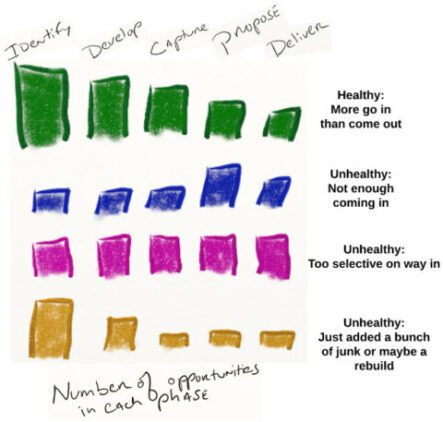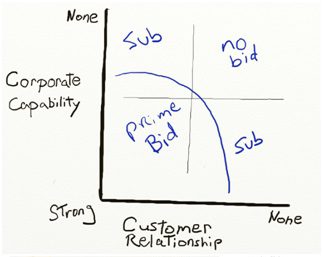“Reading your pipeline.” What does that even mean? Don’t you just look at a list of opportunities and “progress” or “advance” each one? I’m pretty sure someone smarter than me thought about this long and hard and came up with 200 steps to develop a Government business. Well, yes they did, and yes you can buy into the idea that you need Godzilla processes and specialized experts to interpret what you have. It doesn’t have to be—and isn’t—that hard, though. Any pipeline is simply an organized grouping of opportunities arrayed along a path from unqualified lead to awarded contract. What the phases are called and whether there are three or six of them isn’t paramount to your success. Actively managing your pipeline is, however.
Any pipeline is simply an organized grouping of opportunities arrayed along a path from unqualified lead to awarded contract. What the phases are called and whether there are three or six of them isn’t paramount to your success. Actively managing your pipeline is, however.
Reading your own pipeline can tell you a lot. How? For illustration purposes, suppose your pipeline has five phases: Identification, Development, Capture, Proposal, and Delivery. It is really unlikely you will win everything you bid on, and it is also unlikely that your firm will be able to pursue every identified opportunity. Based on this, you would expect a healthy and normal pipeline to look like the top row at left. Various forms of unhealthy profiles like the other 3 shown occur when not enough opportunities are identified when the intake screen is too selective and no stretch opportunities come in, or when no opportunity is ever stopped on its way through. A pipeline that is lopsided to the left may result from a renewed emphasis on “filling the pipeline” and an associated wholesale import of a raft of ill-chosen leads.
Taking a step back and reading the pipeline tea leaves can help you calibrate your process to ensure an appropriately rigorous pipeline. This is a necessary skill set for Business Developers, as is an appreciation for Business Development Pipeline best practices (i.e. what they are and how you implement them). Let’s look at four best practices:
1. Have a well-defined, customized pipeline and a set of decision-making processes that fit your company and its culture. The best practice is to follow a process to make key decisions: Bid or No Bid? Prime or Sub? There is no “magic answer” or “one-size-fits-all” process out there waiting for you to discover it. You need one that works for your company. It needs to be free of emotion, to keep you from wasting resources on something because it looks good or feels right. Some typical questions to ask yourself in this process include:
- Does it fit our strategic direction?
- What is the strength of our client relationship? Can we fix or improve it?
- Do we have a competitive advantage? Does the client favor a competitor? Can a partner improve our odds?
- Do we know the client’s needs and issues? Can we get access to the information?
- Do we have the resources and skills available for the pursuit? Can we get what we need?
- What is the level of risk? Can we mitigate it?
2. Purposefully develop and maintain a team culture that recognizes that everyone is involved in capturing new business. This includes project delivery staff in particular, plus the front desk staff, your contracts manager, and staff… everyone. For example, recruiting or HR can be one of your company’s major intelligence gatherers. A working recruiter gathers more intel about people, customers, prospective clients, and competitors than almost anyone. You need to read them in and keep them in the loop so you can leverage their interactions and information flows.
3. Do your homework and really know your opportunities. A somewhat dated mantra is, “Do not go after opportunities you heard about on the internet first and did not have a hand in before they were publicly released.” I say this is dated because most of us currently have the majority of our interactions with the world on or through the internet. The best practice principle is still valid, though. Temper what you decide to pursue and stay away from random opportunities you first saw after the RFP dropped because they will dilute your efforts and distract you from getting deeper into quality opportunities. Your capture team MUST know the opportunity, including all of its nuances before you act.
 A variation on this best practice is to know and operate in your space, as shown in the accompanying matrix of corporate capability and customer relationship. The matrix is fairly intuitive. Basically, you should be working as a prime in the strong/strong quadrant, because your company has a good relationship with the customer and the work matches your core capabilities. As you move into either of the strong/none areas, the focus changes slightly. You still should consider priming, because of your customer relationship strength or corporate capabilities; however, you may not have all of the core capabilities covered, or you may lack past performance in an area where a solid partner could help. In those situations, you should seek out good partners and work together to cover all of the requirements or, as you go deep into those quadrants, join someone else’s team. The none/none quadrant should be avoided in almost all circumstances, as you have little to gain and a lot to lose there.
A variation on this best practice is to know and operate in your space, as shown in the accompanying matrix of corporate capability and customer relationship. The matrix is fairly intuitive. Basically, you should be working as a prime in the strong/strong quadrant, because your company has a good relationship with the customer and the work matches your core capabilities. As you move into either of the strong/none areas, the focus changes slightly. You still should consider priming, because of your customer relationship strength or corporate capabilities; however, you may not have all of the core capabilities covered, or you may lack past performance in an area where a solid partner could help. In those situations, you should seek out good partners and work together to cover all of the requirements or, as you go deep into those quadrants, join someone else’s team. The none/none quadrant should be avoided in almost all circumstances, as you have little to gain and a lot to lose there.
4. Customer intimacy is king. Your chances of winning drop off dramatically without a close relationship with your potential or current customer. This is not to imply that winning Government contracts is all relationship-based. There are many instances where contracts are awarded on merit, and your Government customers comply with mandates and oversight to ensure fairness and competition. However, the scope is portable, meaning your Government customer has choices for how and where to obtain the work they need. Customer intimacy helps you in understanding motivations, recognizing unstated needs, and producing winning proposals. Customer intimacy also increases opportunities for you to encourage a Government customer to limit competition by specifying NAICS codes/size standards, making additions to existing contracts, or placing orders on specific IDIQs, multiple-award contracts, or federal schedules.
If you are bidding on more proposals than you can handle internally or want to bring in real pros to maximize your chances of getting a Must-Win contract, OST Global Solutions can help. We can also train your staff, create your library of proposal collateral, and establish rigorous processes and plans for every type of proposal. For more information, contact us today by phone at (301) 384-3350 or by email at service@ostglobalsolutions.com.
Contact us to learn more.

